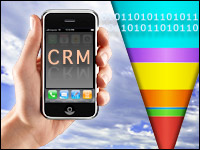
Want to extend your company’s CRM presence in the mobile world easily and effortlessly? Vendors are lining up to help — at least with the first part of that sentence. Sales, service and marketing are all categories in which vendors are actively rolling out products aimed at the mobile space. Whether their deployment, though, is “easy and effortless” is an open question.
Sometimes it is — or at least it comes close to that state — but that’s only if you started out with the “right” CRM application from the beginning.
“The proper platform will expose content via flexible APIs which allow the developers to build what they need without being forced to accommodate data or overhead they don’t,” said Gene Koopman, director of mobile applications at Bluewolf.
Salesforce.com and its REST API access is a good example, he told CRM Buyer. “Right out of the box, it is just as powerful as their native query language. In addition to that, it supports easy and rapid development of custom Web services.”
The Right Middleware Strategy
Even if you’ve made all the right vendor decisions from the beginning, there still will be important decisions that need to be made once a path is set to deploy a mobile CRM application, John Lucker, principal for Deloitte’s advanced analytics and modeling, told CRM Buyer.
Some — perhaps much — of the decision-making will be a matter of “good, hard tech thinking,” he said. For example, when considering whether to implement middleware that extracts, consolidates and normalizes data from primary, internal data sources, the choice comes down to extracting data and putting it out in aggregate form, or pulling it out raw to be used in real time.
“There are a lot of reasons to support both approaches,” Lucker said.
The former is much cheaper and has fewer possible points of failure, he said, than a scenario in which the middleware is configured to extract thousands of transactions and present them in real time.
An example of a middleware mobile CRM configuration in which the data has been extracted and summarized might be a mobile CRM app that shows a customer other purchases that similar buyers have made, suggested Lucker.
The case for presenting data in real time makes sense, though, when the data is constantly changing or is very time-sensitive, and decision-making is in real time as well.
The probability of some kind of system failure is higher in such a case, Lucker said.
“Some companies I have worked with have underestimated the complexity of this kind of data movement,” he noted, “especially when you add wireless to the mix. There are all sorts of complex latency and bandwidth issues that need to be incorporated into a plan.”
Other Sticky Wickets
Other issues to consider for the back end include the extent to which external data sources are necessary to the end product — data sources that the company might not own or control and that will introduce even more additional complexities into the presentation layer.
“The thing with mobile apps, especially mobile CRM apps,” Lucker said, “is that customers expect them to work smoothly. No one wants to be in a position of explaining why a self-service CRM app is buggy and hard to use.”
Also of key importance will be the predictive or advanced analytics that will require business rule engines, he said.
“Those are particularly important components,” Lucker emphasized, describing them as utilities that house repositories of predictive models and receive data input.
In the market and in use for years, business rules engines have been evolving into highly sophisticated products in recent years, he said.
“Companies have been drowning in business rules,” observed Lucker. “Engines that can determine that a particular piece of data applies to business rule model A and then receives another data signal and knows to apply it to model B is an important architectural and functional component to the back end.”
Having this piece properly in place will also help companies get a grip on the additional data they will receive by launching a mobile CRM app. Companies in all industries and of all sizes are always on the prowl for ever more information about their customers’ buying habits. A mobile CRM app, especially in the self-service category, should provide a wealth of new data that an analytics engine can use.
Security Issues
These questions must also be debated with an eye on security. “First and foremost, we have to remember that intellectual property and customer information are a company’s two most important assets,” Jerry Irvine, CIO of Prescient Solutions, told CRM Buyer.
“From a security standpoint, it is important not to open up your IP and customer information directly to a mobile device or the Internet,” he pointed out.
With that warning in mind, Irvine recommended configuring the application server that connects to the back-end CRM system to be VPN-accessible only. It is not convenient — and it’s expensive to boot — but it is the most secure option.
“The way most companies do it is a quick and easy configuration, but that is not necessarily secure — and that is to allow the application server to access data from the back end,” Irvine said.
There are concerns with that approach because application server is public-facing, and hence vulnerable to more risk, he explained. The risk intensifies because mobile devices are usually the most vulnerable point in a company’s network.
























































